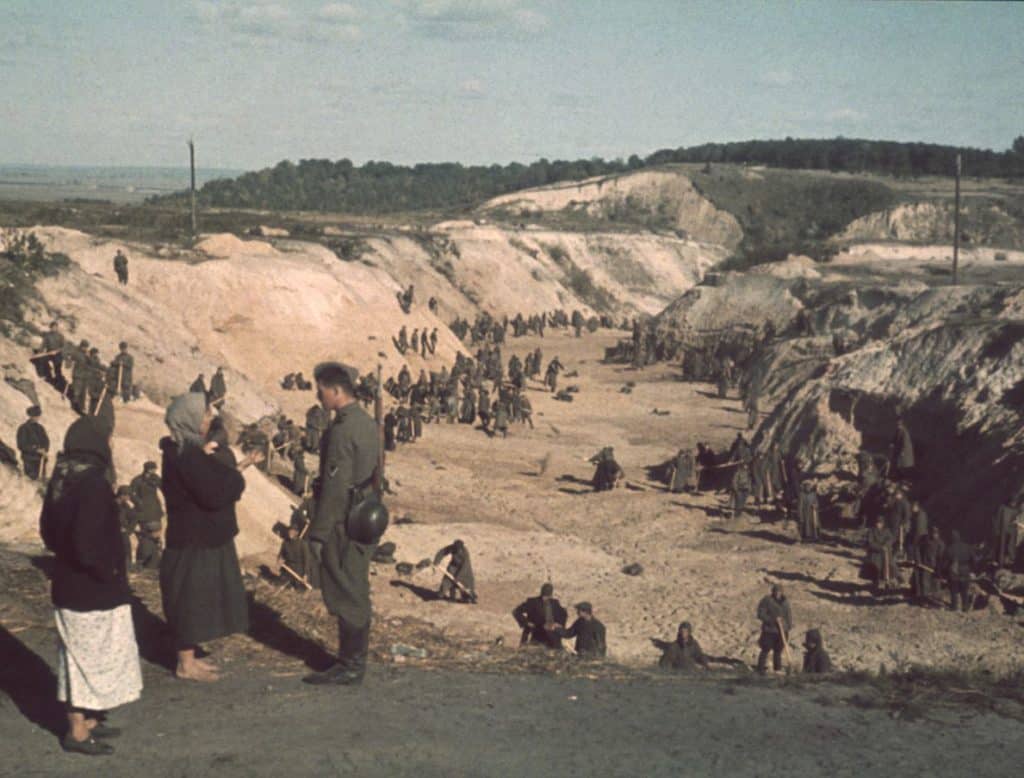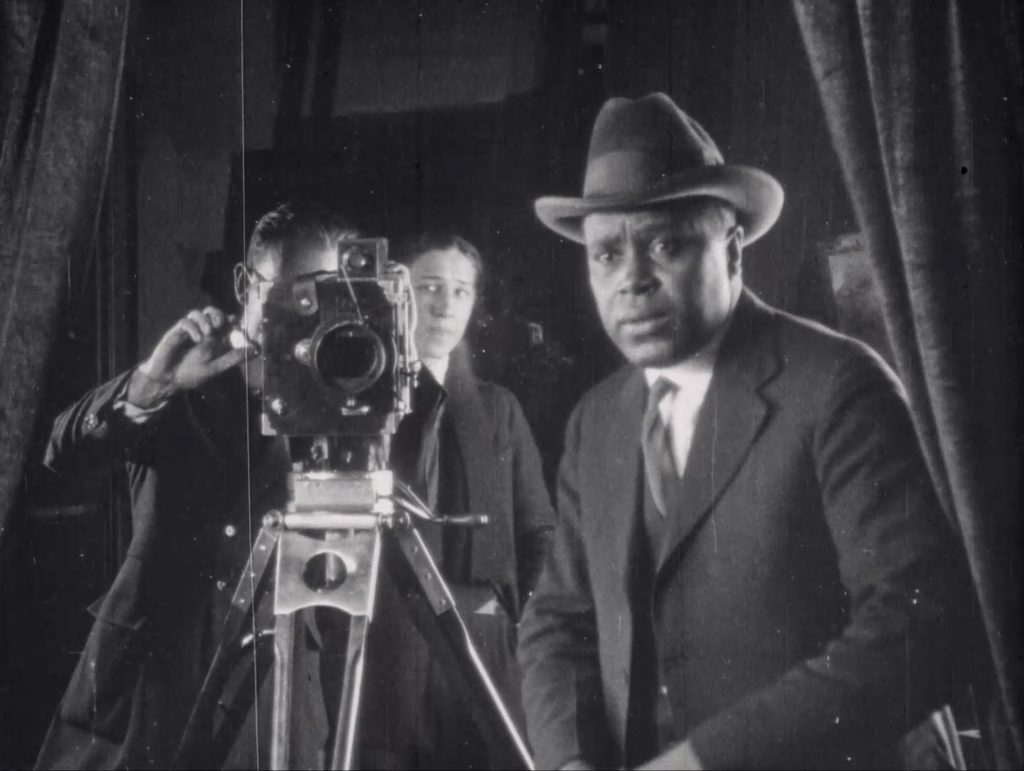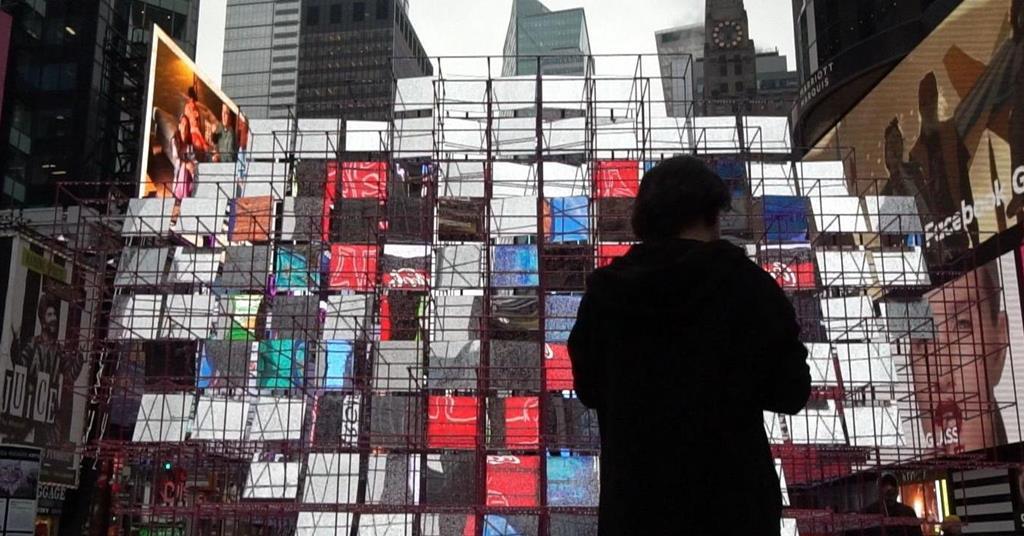A look at the best in the documentary category of the Chicago International Film Festival.
This review is part of our 2021 CIFF coverage.
The three CIFF nonfiction entries considered here are all in love with film. In their unique way, they showcase that adoration through meticulous video-archival research, restoration, and celebration. Babi Yar. Context, Oscar Micheaux, and The Story of Film: New Generation chronicle a moment, a lifetime, and a series of movements; all compositing rare, buried, or local film to tell wide-reaching and profoundly human stories. In each one, we can’t help but be wonderstruck by Cinema’s power to shine a light through the darkness.
Babi Yar. Context
Between September 1941 and October 1943, German and Ukrainian officers slaughtered nearly 100,000 people, including most of the Jews in Soviet Ukrainian. This extra-ordinary event transformed the ordinary Babi Yar ravine into a haunting site of horror and memory. Director Sergey Loznitsa worked intimately with the Babi Yar Holocaust Memorial Center to composite footage taken by both German and Soviet officials to give a complete context to the atrocity.
But the titular ‘context’ is not some kind of generic after-school program march of historical data. It’s a richly layered emotional and visual contextualization through radical lyricism. To chart how a dried-up ravine becomes a river of bodies, Loznitsa masterfully marks out the marching flow of bodies that made up the movement of World War Two. First, we see destruction in the distance, then the approach and latter occupation by legions of footsoldiers, trooping through together and their schools of swastikas.
Some of the cameramen, most likely German, at times, seem to be acutely aware of the camera’s cinematic potential. While sometimes objective and observational, there are moments of aesthetic and stylization. Canted moments that suggest maybe he’d seen and been influenced by Leni Riefenstahl’s Triumph of the Will (1935) or Olympia (1938). Remarkably spliced into footage shot by others, Babi Yar Context becomes a seamless quilt of footage and perspectives that tell a unified story.

What little sound courses through the film is the babbling of the masses. In many ways, this added-in or enhanced background of the unintelligible murmur of the masses is the heartbeat of History. The sounds of crowds carry us along as it changes from drumming drudgery to a trumpeting tenor, then wailing height, and finally muffled and mournful melancholy. The tears, jeers, and cheers feel universal, which is both indicting at times and extremely empathizing at most others.
When spoken words are articulated, it’s in the final arc of the documentary when survivors give their testimony and judges pass judgment on those responsible. We get a sense of the profundity of silence necessary to carry out this atrocious massacre as well as the voices silenced and buried. Water covers up this coverup once again but Babi Yar Context ensures its memory will last for generations.
Oscar Micheaux – The Superman of Black Filmmaking
Legacy is such an important theme in these three films featured at CIFF, all of them working diligently so that future generations “may know.” Italian director Francesco Zippel (Friedkin Uncut) returns to the director-biography in this heartfelt documentary about Oscar Micheaux (1884-1951), a prophetic Black voice in early cinema history who broke new ground in how films were shot and distributed outside and before the studio system. Our guests will say he’s, “the originator of DIY,” the ultimate underdog, “the most important Black filmmaker who ever lived. Period.”
Micheaux’s story has been told before, how he came from Metropolis, Illinois, moved to Chicago during the Great Migration before heading west to make his mark as a filmmaker. We learn about his life working on the railroad and his success as a novelist. But the most exciting parts are the bits of filmmaking that remain.

Micheaux no doubt earns and deserves the praise guests like Chuck D, Amma Asante, John Singleton, Kevin Willmot, and Nicole London ascribe to him. But Oscar Micheaux – The Superman of Black Filmmaking falls into the pervasive (white) American individualist narrative, which seems at odds with Micheaux’s community-driven life and praxis. Micheaux was able to respond to the issues of his times, such as the spine-chilling release of Birth of a Nation (1915), with a highly innovative visual style, yes, but Within Our Gates (1920) was for the good and representation of his fellow Black people that he felt the need to respond.
Even though the film later recognizes the gulf between Micheaux’s respectability politics and the self-criticisms of the early Civil Rights Movement and opens with the community of Metropolis celebrating him, Zippel doesn’t back off from playing into a respectability narrative that does a disservice to everyone. By the end of the film, Micheaux has been separated from his community as the rare Black achievement of the American Dream.
Nevertheless, Zippel and crew have done a remarkable job preserving these rare reels. My biggest hope is that this documentary will inspire restorations and releases of these films for people and schools to have on our shelves so that we might show and share them with others.
The Story of Film – A New Generation
Our final and most summatory entry in our Nonfiction overview is Mark Cousins’ The Story of Film – A New Generation. This wide-reaching follow-up to Cousins’ history of cinematic innovation in the 20th Century asks how filmmaking has built on previous traditions and created new ones. But unlike his previous chapter, this entry is far more racially and gender-conscious. It’s also admittedly borderless which makes for a brilliant bricolage of examples that remain exciting and engaging throughout the entirety of the nearly three-hour runtime.
As always, the joys of watching Cousins work comes from the furious scribbling of titles that you need to see on a tiny notepad in the dark. The global knowledge and commitment Cousins and his research team demonstrate means that there’s ample possibility to introduce unheard-of films to new audiences.
Cousins knows just the right clips to maximize his points and he is even defter at drawing comparisons. Our second course of delights arrives when silly or seemingly incongruous parallels are drawn and we’re tickled by the sudden profundity. Who knew Frozen and Joker side-by-side would reveal such depths of the American imagination?
Split into two halves, the first act will look at how genres (comedies, action, horror, musical/dance/body films, documentaries, and the new Slow Cinema) have reformed old filmmaking processes. The second half looks at technical achievements in the 21st Century that have changed film and filmmaking such as the smartphone boom, interactive media, motion capture, and virtual reality.

Like Zippel’s Oscar Micheaux, Cousins is also prone to Grand Narrativizing that undermines his goals and ideals. This new chapter of his Story of Film series continues Cousins’ exceptional eye for comparison, often hilariously poetic and Lacanian prose, and a habitual tendency to add superlatives at every turn.
That’s the trouble when you set “innovation” as your rubric. It is so densely structured by racist, sexist, and anti-queer criteria that one is bound to fall into its traps. Though The Story of Film – The New Generation eloquently shows how the medium of cinema globally builds and borrows, so single out films and directors as “the best” defeats all sense of “sharing” that seems vital to Cousins’ messaging.
Because at the end Cousins compassionately asks us to consider the context of cinema during COVID-19. Though the film seems to suggest the pandemic is somehow over (lulz), Cousins’ astute observations about the “electrified” space created by social distancing show us how making and watching films is already adapting to new situations.
As in all of these documentaries, The Story of Film – A New Generation celebrates cinema’s community-building potential. Each demonstrates the cinema’s power to show perspectives radically different from our own.
In watching these three films-of-films at CIFF, it becomes touchingly clear how important it is we globally preserve films and that we share them as widely as possible. Because within the darkness is the stuff dreams and hopes are made of.
Read next: The Spool's Best New Releases
Streaming guides
The Best Live TV Streaming Services With Free Trial
The praises of live TV streaming services don’t need to be further sung. By now, we all know that compared to clunky, commitment-heavy cable, live TV is cheaper and much easier to manage. But just in case you’re still on the fence about jumping over to the other side, or if you’re just unhappy with ... The Best Live TV Streaming Services With Free Trial
How to Watch Power Book III: Raising Kanan Season 3
Season 3 of the hotly anticipated Power spin-off, Power Book III: Raising Kanan, is arriving on Starz soon, so you know what that means: it’s the ’90s again in The Southside, and we’re back with the Thomas family as they navigate the ins and outs of the criminal underworld they’re helping build. Mekai Curtis is ... How to Watch Power Book III: Raising Kanan Season 3
How to Watch Doctor Who: 60th Anniversary Specials
Ladies and gentlemen, we’re so back! To celebrate Doctor Who’s 60th anniversary, the BBC is producing a three-episode special starring none other than the Tenth/Fourteenth Doctor himself, David Tennant. And to the supreme delight of fans (that would be me, dear reader), the Doctor will be joined by old-time companion Donna Noble (Catherine Tate) and ... How to Watch Doctor Who: 60th Anniversary Specials
Which Netflix Country has Interstellar?
Maybe you’ve just seen Oppenheimer and have the strongest urge to marathon—or more fun yet, rank!—all of Christopher Nolan’s films. Or maybe you’re one of the few who haven’t seen Interstellar yet. If you are, then you should change that immediately; the dystopian epic is one of Nolan’s best, and with that incredible twist in ... Which Netflix Country has Interstellar?
Which Netflix Country Has Each Movie of The Hunger Games?
For whatever reason, The Hunger Games series isn’t available in the same countries around the world. You’ll find the first and second (aka the best) installments in Hong Kong, for instance, but not the third and fourth. It’s a frustrating dilemma, especially if you don’t even have a single entry in your region, which is ... Which Netflix Country Has Each Movie of The Hunger Games?
How to Watch ESPN With A Free Trial
One of the major concerns people have before cutting the cord is potentially losing access to live sports. But the great thing about live TV streaming services is that you never lose that access. Minus the contracts and complications of cable, these streaming services connect you to a host of live channels, including ESPN. So ... How to Watch ESPN With A Free Trial
How to Watch Paramount Network With a Free Trial
To date, Paramount Network has only two original shows on air right now: Yellowstone and Bar Rescue. The network seems to have its hands full with on-demand streaming service Paramount+, which is constantly stacked with a fresh supply of new shows. But Yellowstone and Bar Rescue are so sturdy and expansive that the network doesn’t ... How to Watch Paramount Network With a Free Trial
How to Watch WE TV With a Free Trial
Previously “Women’s Entertainment,” We TV has since rebranded to accurately reflect its name and be a more inclusive lifestyle channel. It’s home to addictive reality gems like Bold and Bougie, Bridezillas, Marriage Boot Camp, and The Untold Stories of Hip Hop. And when it’s not airing original titles, it has on syndicated shows like 9-1-1, ... How to Watch WE TV With a Free Trial
How to Watch Comedy Central With a Free Trial
It’s no coincidence that many of today’s biggest comedians found their footing on Comedy Central: the channel is a bastion of emerging comic talents. It served as a playground for people like Nathan Fielder (Fielder For You), Ilana Glazer and Abbi Jacobson (Broad City), Tim Robinson (Detroiters), and Dave Chappelle (Chappelle’s Show) before they shot ... How to Watch Comedy Central With a Free Trial
How to Watch FX With a Free Trial
You’d be hard-pressed to find a bad show airing on FX. The channel has made a name for itself as a bastion of high-brow TV, along with HBO and AMC. It’s produced shows like Atlanta, Fargo, The Americans, Archer, and more recently, Shogun. But because it’s owned by Disney, it still airs several blockbusters in ... How to Watch FX With a Free Trial
How to Watch A&E With A Free Trial
If you’re a fan of true crime and insider docu-shows like The First 48 and Court Cam, then you’re probably already familiar with A&E. The cable channel is home to other reality TV gems like Hoarders, Duck Dynasty, and Storage Wars (they’ve moved on to spin-offs like Road Wars, Customer Wars, and Prison Wars now). ... How to Watch A&E With A Free Trial